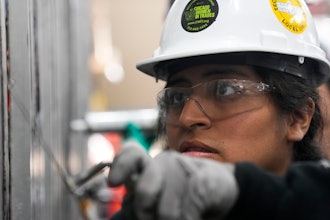
Manufacturing may never recover the number of jobs it has lost over the past three-plus decades, primarily because of the increased use of automation, the Wall Street Journal reports, based on its monthly survey of economists.
Forty-seven percent of the respondents said automation was the leading cause in the decline of manufacturing jobs, while 18 percent said automation and offshoring had played roughly equal roles. About 28 percent said offshoring had been the primary culprit.
The survey of 62 economists was conducted from Dec. 2-6. The respondents were a mix of academic, financial and business economists.
The respondents estimate the U.S. will add about 7,000 manufacturing jobs by the end of 2017, about 40,000 by the end of 2018 and about 50,000 by the end of 2019, WSJ reported. The forecast indicates that although jobs will increase, the pace is far too slow to replace what has been lost.
“After hitting a record of nearly 20 million in 1979, the number of American factory workers has plunged during each of the last five recessions and each time has never recovered. Today, 12.3 million people are employed in U.S. factories, a loss of nearly eight million jobs,” the Journal said.
The National Association of Manufacturers (NAM) says employment in the manufacturing sector has dropped for four straight months. About 4,000 manufacturing jobs were lost in November while there are 60,000 fewer workers on a year-to-year date.
NAM notes the dropoff in employment but says the future is looking better for the industry. It says manufacturing leaders are cautiously optimistic about demand and production for 2017, and expect that this increase in activity would lead to additional hiring. That conclusion is backed by the economists surveyed by the Journal who expect 2.4 percent economic growth over the next two years, up from pre-election estimates of 2.1 percent.
They also expect the unemployment rate to be lower and interest rates and inflation to rise. The odds of a recession in the next 12 months declined slightly in this month’s survey to 17 percent, down from 20 percent in the survey before the election.
Every major study notes the role that productivity is playing in the number of employees working in manufacturing. One such study conducted last year by Ball State University says that three factors have contributed to changes in manufacturing employment in recent years: Productivity, trade and domestic demand.
“Overwhelmingly, the largest impact is productivity. Almost 88 percent of job losses in manufacturing in recent years can be attributable to productivity growth, and the long-term changes to manufacturing employment are mostly linked to the productivity of American factories,” WSJ's report says.
The study points out that growing demand for manufacturing goods in the U.S. has offset some of those job losses, but the effect is modest, accounting for a 1.2 percent increase in jobs beyond what would be expected if consumer demand for domestically manufactured goods was flat.
Meanwhile, a separate report from Deloitte and the Council on Competitiveness shows that the use of technology and innovation are among the reasons that the U.S. will surpass China as the number one competitive nation in the next five years. Germany, the report says, will be in the number three position.
The 500 global CEOs surveyed in the study say advanced manufacturing technologies are key to unlocking future competitiveness:
“As the digital and physical worlds converge within manufacturing, executives indicate the path to manufacturing competitiveness is through advanced technologies, ranking predictive analytics, Internet-of- Things (IoT), both smart products and smart factories via Industry 4.0, as well as advanced materials as critical to future competitiveness,” the report says.
The 2016 Global Manufacturing Competitiveness Index (GMCI) report is the third study prepared by the Deloitte Global Consumer & Industrial Products Industry Group and the Council on Competitiveness, with prior studies published in 2010 and 2013.






















